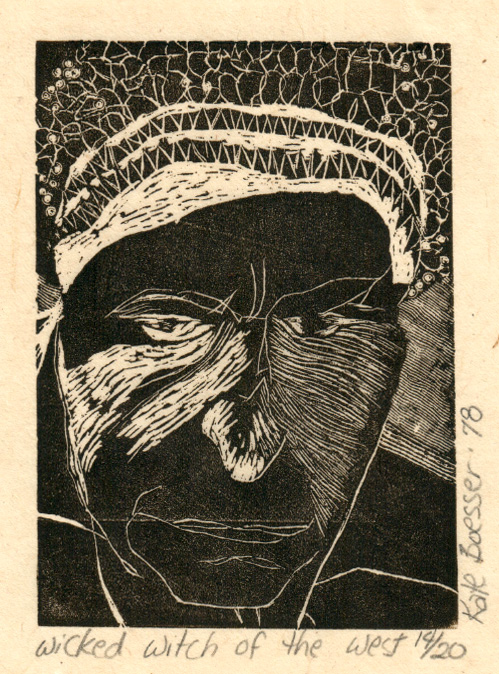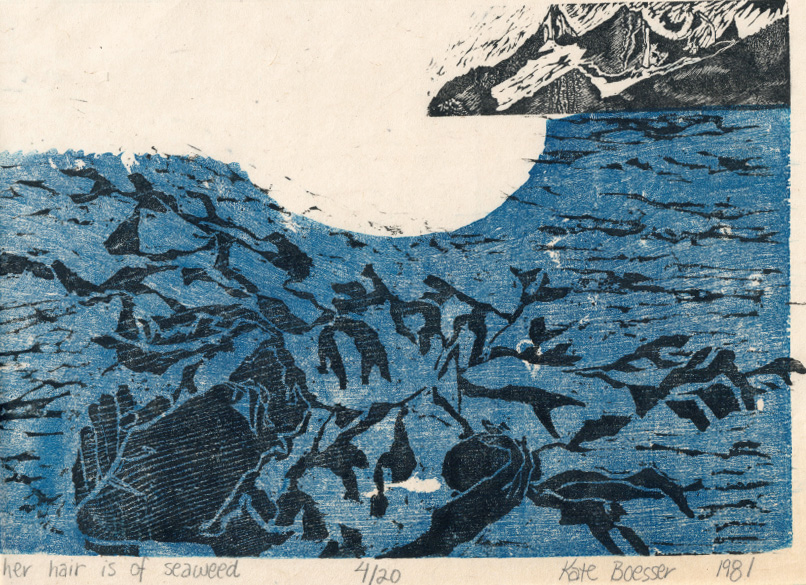A Blog of Flashbacks The Shadow
April 2023
THE SHADOW ©
By Judith Aftergut
Judith Aftergut, a guest blogger to my site this month, is an Oregon writer. Goose Cove Press published her book, If a Place Could Speak, in 2015. The artist, Kate Boesser, is a longtime Alaska artist with multiple shows and published books to her credit. My favorite Boesser book is Silverbow’s Basin, Roundabout Studios, 1979. The writing and the artwork, below. are both copyrighted by their creators, Judith and Kate. I appreciate their participation in my Flashbacks April 2023 blog. At age five, I had a recurring nightmare after watching the movie of the Wizard of Oz. The death of the Wicked Witch of the West repeated night after night. I heard the witch’s laugh, saw her black dress, and watched terrified as she dissolved. What was so frightening? That a human could melt like ice? Did the witch remind me of my mother and that I needed her no matter what? Many of us first meet the difficult parts of ourselves in stories we hear when we are young.
 |
The Wicked Witch of the West. © Kate Boesser, 1978. With permission of Kate Boesser. |
In a fairy tale, a witch offered food to a sister and brother. I wanted to scream, “It is not good for you! Don’t eat it!” The children in the story of course don’t listen to me. They eat the food. They suffer. They survive. Eventually the witch dies. The children go home. They live happily ever after.
In fact, we must all eat that food. That process of eating what isn’t good for us, of doing what we shouldn’t do, of not honoring ourselves--that shadow is part of us. We eat fear, shame, sadness, humiliation, and anger over and over. We metabolize it, we own it as part of ourselves; we are it, we find in ourselves that same energy of the witch that we previously thought was outside.
By being naïve, by rebelling, sometimes by being tricked, we learn, maybe the next time, maybe long after, not to eat that food—not to act out one more time --a desire to get even with a parent or to serve the lover who doesn’t love us.
We metabolize within ourselves that nourishment that does not nourish, until we come to know it in ourselves and recognize it in others. Repetition: we do it again and again. We begin to notice when the same old feelings show up. Finally, we learn to laugh at ourselves—to laugh in recognition, as old timers I once interviewed did. We have a sense of compassion for ourselves; we have compassion when we see this behavior in others.
In one part of my childhood dream, the Wicked Witch of the West chased me into a well. I recognized that witch’s energy later: the energy of my mother, who combined the witch in the Wizard of Oz and the tornado. When I was young, a friend who saw Mother serve me breakfast in bed when I was sick thought my mother was the best mother ever. Beneath the surface, it seemed to me that part of my mother did not wish me well.
I found myself inside that dream again as an adult in a Holotropic Breathwork™ session, where you listen to music, carefully chosen, and breathe deeper than usual. The combination put me, as intended, into a meditative state. A trained facilitator led the process, and I had a companion sitting nearby to keep me safe in that altered state. Stanislaus Grof, a Czech psychiatrist who did some of the early LSD research developed this method. Once LSD and that research became illegal, he looked for a way to access those kinds of altered states without drugs, the varieties of access to those states that people had discovered over millennia: dance ‘til you’re overtaken; drum; eat magic mushrooms; turn in circles like the Sufis until you succumb to ecstasy; or fast for a day or two.
I knew from my childhood dream that the bottom of the well was dry. There must be water under it. Why had this never occurred to me? After all, it was a well! In the altered state of consciousness of Holotrophic Breathwork, I found a shovel. I dug down beneath it to find water. Below the dry bottom of that well I discovered a subterranean stream.
The stream flowed horizontally underground to a tree, which sucked the water up through its roots. The water flowed up through the trunk and into the branches and then into the leaves of the tree. The water evaporated from the leaves in the form of water vapor and formed itself into clouds. Lightning flashed from the clouds, and thunder clapped. Rain fell into the dry well.
Some people learn from taking a path that focuses upward, always concentrating on the light; some people take the downward path first. They learn by going into the dark.
Whichever spiritual direction you tend to go first, whatever your predilection, it all becomes a cycle, a circle. Whether you first go up or down, eventually you come out in the same place. Go down first and later you explore the heights. Go up and later plumb the depths.
I lived the dream of the wicked witch in this altered state and came out with a new sort of map. I could deal with any new problem by asking: “Where am I in this unknown territory? Is the witch still chasing me? Have I fallen into the well? Have I reached the dry bottom of the well? Have I found the subterranean stream? Am I floating in it? Have I reached the roots of the tree?”
 |
Her Hair Is of Seaweed. © Kate Boesser, 1981. With permission of Kate Boesser. |
I could see how far along I was in solving the problem. That map helped me to accept wherever I landed. I wasn’t in totally unknown territory! I had found the bottom of the well! I was floating in the underground stream. In the mystery of what the future held, or when looking for the outcome of a new issue with my mother, I could discern where I was in a process whose outcome I couldn’t yet see. I had an invisible road map that helped deal with the anxiety, the fear.
How do you ‘honor’ the shadow side of yourself or of someone else? You ‘own’ it. You accept it as part of yourself. Andrew Hahn, Ph.D. a psychologist, says that you metabolize it. You digest it. It becomes part of your cells. You know the shadow side is there. You ‘eat’ it, digest what could be poison and transform it into nourishment. You make it conscious. You honor the shadow’s existence.
What do you do with the shadows—the parts of yourself and others you don’t like? How do you honor those aspects of being a human being? The Persian Sufi mystic poet, Rumi, wrote a poem called The Guest House. Rumi’s poem tells us how to respond, nine centuries after he wrote it:
“The dark thought, the shame, the malice,” Rumi writes. What should we do? His suggestion is to welcome and entertain all of these parts of yourself as you would welcome a guest. “Meet them at the door laughing,” is Rumi’s idea.
In my interpretation, Rumi means to honor this new awareness, to treat it with reverence. Work to be amazed. Otherwise you may fail to notice that, in Rumi’s words, “a crowd full of sorrows” might be “a gift from beyond.”
Without taking time to look at your jealousy, rage, fury, envy as an opportunity to build your own awareness, you may resist them, try to ignore or get rid of them. You might even act them out.
You can honor (accept) anything and anyone in this world, anything that exists. You can honor things you wish weren’t happening-- a bipolar mother, the death of a child, the Holocaust in Europe. You accept that it happened, even if you don’t like it. At any moment, the world is the way it is. Which doesn’t mean we can’t change it, but it is useful and works better to accept it first.
“Do not fight against pain; do not fight against irritation or jealousy. Embrace them with great tenderness, as though you were embracing a little baby,” wrote Buddhist monk Thich Nhat Hanh. “Your anger is yourself, and you should not be violent toward it. The same thing goes for all of your emotions.”
You can honor people and events you don’t like, and accept that you don’t like them. You can discover and acknowledge (honor) the presence within you and outside of you of emotions you don’t appreciate. By working to be more conscious, you honor the parts of yourself that dishonor.
The first step is to honor, that is, to breathe the data and feelings in. You don’t try to change anything. “I hate this person! Just accept that I hate them?” you think. “Just accept that I’m furious? I want to do something to express that fury! I’m supposed to just be still and notice it? You’ve got to be kidding!”
Once you notice that your hatred exists in the world and you can let it be what it is, you have taken a courageous first step. First you accept that your hatred exists; then you see if you have an intention to change it. Is there is an action to take that honors your new awareness. You might simply choose to be a witness; or there might be more to do. Whether to act or not will become clear, even if not immediately. But first you must accept, that is, if you want to honor yourself--if you want to be conscious.

|
